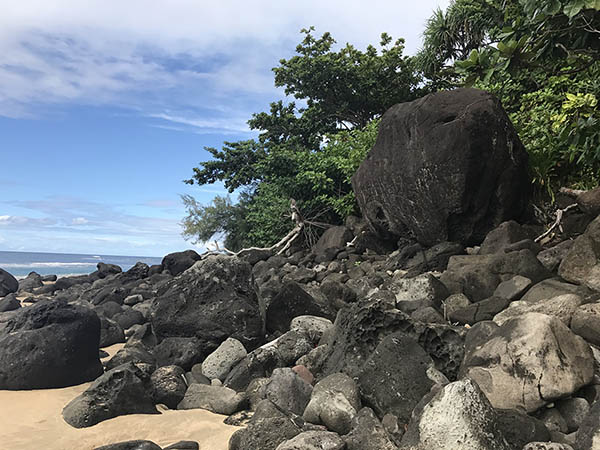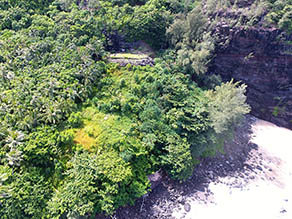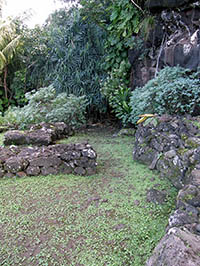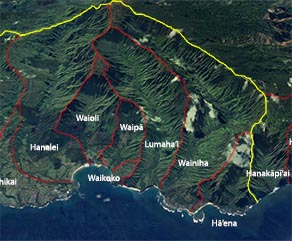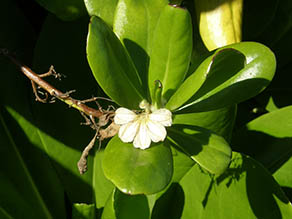 |
 |
 |
 |
||||||
|
|
|
|
|
|
|
|
|
|
 |
|
 |
 |
|
 |
 |
“The body of Kili‘oe,” writes Uncle Bruce, “one of the two mo‘o sisters who guarded Lōhi‘au’s body, became a furrowed rock beside the sea that is still used as a birth rock, a place for the safeguarding of the umbilical cord of a newborn. In so doing, the child was placed under the protection of Kili‘oe. The ancients believed that the fate of the umbilical cord foretold the child's life.” Carlos says. “References to Kili‘oe and Kalanamainu‘u, two mo‘o (beings of lizard- or dragon-like aspects) women who confronted Pele when she arrived at Hā‘ena, speak of a Hawaiian belief about ancestors of the distant past who take on the form of animals in order to associate with the world of living human beings. In the story of Pele, Lōhi‘au, and Hi‘iaka, the mo‘o women suspect Pele is no ordinary mortal and challenge her, trying to get her to reveal her true identity. Pele makes short work of them in a battle of wits and words, revealing their identities as mo‘o guardians of the cliffs of Kē‘ē and sending them into hiding. “Later in the story, these mo‘o women steal Lōhi‘au’s spirit out of his body after he dies in the wake of his love affair with Pele, and hide it in a cave high in the cliffs above Kē‘ē. Sent by Pele to retrieve her sister’s lover, Hi‘iaka spies the lingering spirit of Lōhi‘au near the entrance of the cave, beckoning wistfully to her. Hi‘iaka and her traveling companion Wahine‘ōma‘o climb to the cave despite serious assaults by the mo‘o women, eventually defeating them after an exhaustive battle. It is at Kē‘ē that Hi‘iaka and Wahine‘ōma‘o restore the spirit of Lōhi‘au to his body and nurse him back to good health. “Kili‘oe, the mo‘o woman, remains in Hā‘ena today in the form of a stone, readily identifiable by its curiously honeycombed surface and its huge size. It is located at the base of the cliffs northwest of the heiau Keahualaka.” “Kili‘oe was said by some to part mo‘o” relates Chipper, Uncle Bruce’s nephew. “I don’t know if you would call her a kupua. But she was also a kumu hula that this area was famous for. And there’s a neat mo‘olelo from this area related to the naupaka. The naupaka is a beach plant and a mountain plant, and the Hawaiians call it naupaka kahakai for the beach plant, and naupaka kuahiwi for the mountain one, and each plant produces the half flower. And when you put the two half flowers together, they match. And so there are stories about this on all the islands, several of them are associated with Pele and how she separated these lovers and turned them into plants. And the legend form this area has to do with two hula students, who were students of Kili‘oe.” “The hula school down here was the most revered of the hula schools. It was not for the faint-hearted to enter into scholarship at this halau, because it was expected that you would literally dedicate your life to learning. There were many strict kapu that governed the protocols of being a haumana in the halau. Part of the kapu was that there was to be no sexual relationships between the students. “In this story, two of the students, in spite of their dedication, found that they were unavoidably attracted to each other. They could not resist the power of love that was overtaking them. So they prayed on it, and thought about it, and asked the goddess Laka to release them from their vow of dedication, and offered as a ho‘okupu, a maile lei and a haku lei at the Ke Ahu a Laka, and left in the middle of the night.” “The story says that Kili‘oe, in the middle of the night, was awakened by a mo‘o who was making some kind of hissing noise, and awoke her to be alert. Because she was part mo‘o, Kili‘oe had mo‘o watchdogs, you might say. And she listened with her supernatural powers and she could hear the splashing of feet going through Limahuli stream. So she got up and began to chase after the two students that were running away. And she chased them and chased them. “As she was chasing them, the sun began to come up. She chased them all the way to Lumaha‘i, and when they got the point they realized that she was gaining on them and she would surely catch them, and so the boyfriend told his lover, he said that he was going to stay and hide in a cave here in the cliff, and for her to climb on up that ridge there, and he would distract Kili‘oe and allow his wahine to escape. So he hid in a cave and she kept climbing up the cliff. And just as Kili‘oe came by, he jumped out and made some kind of ruckus, to distract her, and she struck him with her ko‘o, her stick, and killed him.” “Then she began following the wahine up the cliff, and when she looked back and saw that her lover had been killed, she lost fight, and so she actually turned around and came down, and Kilioe killed her up there on the ridge. Then Kili‘oe went back to the halau. “The next morning, to her surprise, a fisherman came up to see her, knowing that she was a high priestess, closest to Laka, the goddess. And Laka is not only goddess of the hula, but goddess of the forest, and of the wild growth and the plants. So he came to see Kili‘oe, because to his amazement, every morning he went down to this point to go fishing, and this morning when he came down, there was this new plant that he had never seen before, growing there. And he brought this plant and showed her, there was this blossom on the plant. And indeed, Kili‘oe had never seen it either.” “That afternoon, a birdcatcher came down from the mountain, and he climbed down the ridge from Lumaha‘i, and he came to see Kili‘oe, because as he came down the ridge, which he had traveled often, there was another plant, that he had never seen before, and he brought it to Kili‘oe. And when she looked at it, and she saw the half-flower that matched the one that the fisherman had brought, she saw that when they went together, they made a perfect match. 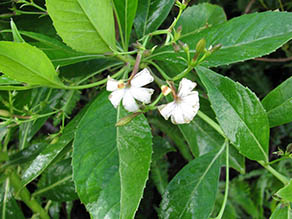
“At that time, she realized what had happened, and that Laka had turned these students into plants, and she realized that Laka had released them from their vow, and that she had blessed them, and that Kili‘oe had really acted improperly in punishing them for what she perceived to be breaking of the kapu.” “And so she went up to Ke Ahu a Laka to make amends, to pray to Laka. And when she got up there, she discovered this lei that the students had left there. And there, to her surprise, on top of the lei, dead, was her mo‘o. “So in the Hā‘ena version of naupaka, it’s one in which, in a sense, the lovers are brought back together, in the plant kingdom. Although they are forever separated—one grows in the mountains and one grows by the beach—they live together as plants.”
|
 |
||
 |
On the next page we will hear about the Piliwale Sisters, and other minor stories from Hā‘ena.
|
 |
||
 |
|
 |
||

|
|
||||
| Copyright 2018 Pacific Worlds & Associates • Usage Policy • Webmaster |
||||
